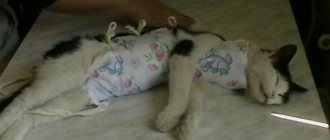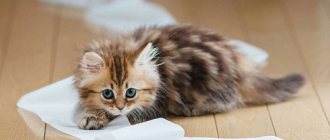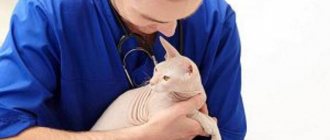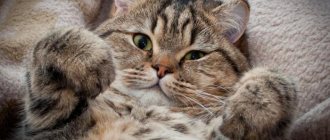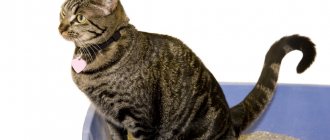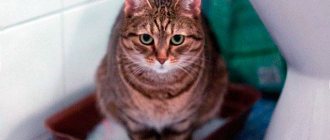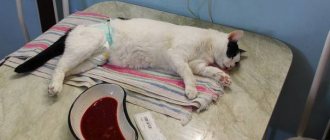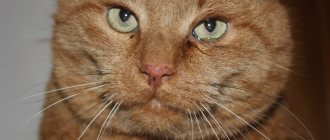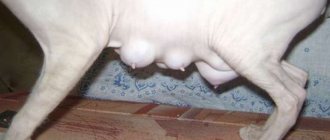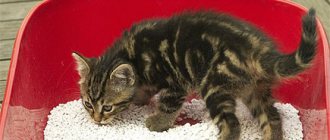I’ll tell you my point of view right away: all cats that do not participate in breeding must be sterilized. It's not just about unwanted kittens. This operation is necessary for the cat itself in order to live a long, quiet life.
Despite the low rate of complications, the sterilization procedure must be approached responsibly. In this article I will talk about what problems there are after castration of females, as well as how to avoid them!
—>
Constipation in a cat after sterilization: what to do, why it occurs
I always warn my patients: after sterilization, the cat should pee regularly, but at first there may be no stool. If after 3 days the pet does not go to the toilet in a big way, you need to take action.
There are several reasons for intestinal dysfunction. Firstly, this is a long-term starvation diet. Before anesthesia, you can feed the cat 10-12 hours. But if the operation is scheduled for the middle of the day, owners can increase this interval (do not feed the cat in the middle of the night!). Plus, the cat does not receive food for some time after the operation. As a result, she simply has nothing to poop with; it takes time for feces to form.
The second reason is the effect of drugs that are used for anesthesia in cats. Agents for intramuscular anesthesia (Domitor, Rometar, xylazine) not only significantly reduce body temperature in animals, but also affect the motility of the digestive tract. Because of this, intestinal peristalsis on the first day after surgery may be sluggish, and vomiting is possible.
The third reason for constipation after sterilization is simple stress associated with a trip to the clinic, surgery and wearing a blanket. Clothes can irritate your cat and make it difficult for you to get comfortable in the litter box.
If on the 3-4th day after the operation there is no long-awaited pile in the tray, you need to give the cat a mild laxative. It could be:
- A teaspoon of petroleum jelly (about 3 ml)
- A tablespoon of condensed milk half and half with water.
Vaseline oil is given twice a day until the cat has a bowel movement. This is liquid paraffin, the product has no taste or smell, and most importantly, it is not absorbed at all in the digestive tract. It is sold in human pharmacies, no other oil is suitable!
Dangerous conditions or complications
Attention!
The first few days after sterilization, it is necessary to monitor the animal’s condition very carefully. The best way out of the situation would be to leave the cat under the supervision of veterinarians.
If the cat remains at home, then you need to monitor her very carefully and immediately contact the clinic in case of alarming symptoms:
- inability to go to the toilet three days after surgery;
- severe bleeding of the suture;
- an increase in body temperature (above 39 degrees) or a strong decrease (below 37 degrees) after a few days;
- swelling of the suture or its suppuration;
- depressed state of the animal;
- refusal of food and water even several days after sterilization;
- pale color of mucous membranes;
- abdominal pain and severe bloating.
What might the symptoms indicate?
- Pale mucous membranes in an animal may be a sign of internal bleeding.
- Symptoms may indicate that your cat has had a volvulus.
- Another complication is intestinal obstruction.
- The inflammatory process at the site of the suture can also cause complications.
READ Supplements for pigs for growth: vitamin and biological compositions
Important!
If you notice any symptoms, do not delay and take the cat to the veterinary clinic, because she needs urgent help!
If a cat has diarrhea, then a completely different approach to solving the problem is needed. Recognizing diarrhea is not at all difficult, because its main difference is liquid feces.
If your pet has diarrhea, you need to take it to the veterinarian. He will measure the animal’s body temperature, determine the degree of dehydration, and palpate the tummy and internal organs. In addition, the clinic will perform some tests:
- examination of urine and feces (for the presence of worms, for hidden bleeding);
- blood analysis.
Treatment for the disorder will depend on its severity, duration and, most importantly, the cause of its occurrence.
In some cases, it is enough to provide the cat with rest and keep it on a starvation diet for one day.
If a cat experiences fluid loss, it must be replenished through intravenous drips or oral administration. When feeding, you need to follow a diet, and the portion of food should increase gradually.
If diarrhea is a consequence of an infection introduced during sterilization, then in addition to all the above actions, special treatment is also included, which is prescribed by the doctor.
If the following symptoms are detected while caring for your cat, you should immediately contact a veterinarian:
- Heartbeat disturbance.
- Breathing disorders. The appearance of wheezing during breathing.
- Swelling of the tongue or eyelids.
- Excessive pallor or brightness of the mucous membranes.
One of the important factors is to provide the pet with complete peace, silence, and isolation from other animals during care. Carefully take care of the wound and the toilet, and then he will quickly recover and will delight you with an attractive and healthy appearance.
Folk remedies
Vaseline oil has become quite widespread among folk remedies. It must be given to the cat in the morning on an empty stomach. The dose is calculated according to the weight of the pet; one milliliter of Vaseline oil should be added per kilogram of the animal’s body weight. After taking the medicine, you must wait until the evening. If the cat still does not go to the toilet, give your pet another dose.
Some pet owners advise feeding their cat Vaseline oil every hour, while increasing the serving size. This opinion is based on the fact that when using petroleum jelly, the product is not absorbed into the intestines, due to which its undigested remains simply flow out of the anus. If the cat does not want to drink the oil, the required dose can be poured into the animal’s mouth from a syringe without a needle.
Another folk remedy is regular or condensed milk . It is recommended to buy classic condensed milk, which consists, in addition to milk itself, only of cream and sugar.
Adequate reasons for “delays” of the trip
So, the anesthesia has passed, but the pain syndrome remains, which each animal perceives differently. Some lead normal lives, eat and drink, while others lie indifferently and refuse food and water. In this case, the cat simply will have nothing to go to the toilet with.
What to do? You can try giving the cat water from a syringe (without a needle). Don't worry about it being harmful.
Excess fluid will be released along with urine, and you will help the animal’s body escape from dehydration and start normal life processes.
Another reason for delayed bowel movements may be the blanket worn after surgery.
Many animals feel uncomfortable in any clothing and, having freed themselves from it, immediately run to the toilet. However, in this case, you cannot leave the cat alone and make sure that she does not start licking the seam.
After all the necessary tasks, be sure to put the blanket back on. Veterinarians do not recommend this method and say not to remove the blanket for a week to avoid serious complications.
Attention!
Sometimes, after surgery, animals walk in a small way unnoticed, wearing a diaper and a little at a time. This is a normal reaction to surgery and there is no reason to worry.
If no dangerous symptoms are observed, the cat eats and even goes to the tray in a small way, but does not get ready to go in a big way, while meowing and straining, then she needs help!
To get rid of reflex constipation and cause a trip to the toilet, it is usually enough to feed the animal with liquid food, broth and give the pet laxatives.
Important!
Only a veterinarian can prescribe a laxative to an animal! Do not self-medicate under any circumstances.
The only safe and harmless remedy for your pet is a light tummy massage, but only with the approval of the cat. If she doesn't mind, then you can stroke your belly in a circular motion.
Laxatives
Microlax enemas are widely used for our little brothers. The product is not dangerous for a small organism, because it is not absorbed by the intestinal walls and is not digested.
READ Do-it-yourself aquarium cover with lighting
For a cat, half the contents of one enema is enough, but only a doctor can prescribe the exact dosage based on the clinical picture.
The drug "Duphalac" is aimed at normalizing the functioning of the stomach and gastrointestinal tract as a whole. The product is effective and does not cause harm.
The advantage of this product is that it starts to act very quickly. The veterinarian will prescribe the dose required for the animal. To offer a cure, it is best to mix the syrup or powder with the animal's favorite food.
The drug "Lactusan" is a pribiotic and is used to treat constipation in cats. It comes in many forms: tablets, suspensions and syrups. "Lactusan" has a laxative effect and makes it easier to go to the toilet. It can be given with food or dissolved in water. Use with fermented milk products is not recommended.
Petrolatum
Vaseline is a natural remedy for constipation. You need to use pharmaceutical vaseline oil.
It does not have the ability to be absorbed into the body, it perfectly softens the intestinal walls and feces, which, after using the product, are easily passed out.
Despite the many advantages of the drug and its harmlessness, you should consult a doctor before use.
Typically, the prescribed dose of petroleum jelly is 0.5 milliliters. You need to drink this amount of oil every few hours.
In addition, there are suppositories based on petrolatum oil, which are widely used for constipation in cats. One candle for a cat will be too much, which is why it needs to be cut in half.
You can try making an enema of pure water using petroleum jelly. It has an enveloping effect and soothes. After the enema, defecation occurs approximately two hours later.
Trichobezoars: ingesting their own hair
For 7-14 days, depending on the doctor’s recommendation, the cat walks in a blanket or collar after sterilization. This is necessary so that she does not lick the seam. But as a result, the cat is deprived of the opportunity to wash its entire body and tidy its fur.
After the blanket is removed, the cat begins to lick itself furiously. All this time the wool fell out, became tangled under the blanket, but was not renewed. As a result, the animal swallows a huge amount of its own fur. Of course, if you have a Sphynx or Cornish Rex, there is nothing to worry about. And if the cat is a long-haired breed (Maine Coon), it must be combed with a furminator after you take off its clothes.
Trichobezoars, hairballs, are manifested either by periodic regurgitation (vomiting) or by the same constipation (see point No. 1).
Ways out of the situation
Partial solutions to the situation logically follow from the above reasons. Let's go over them in more detail again. So, the cat has stopped going to the litter box, what should you do in practice? If it’s not a matter of illness, the fluffy is healthy, then you need to “activate” the mode of total observation of him and analyze the “data” obtained. We keep the tray and the area around it in perfect order. We empirically select a filler that the pussy will like and provide it with maximum privacy. We neutralize any stressful situations. If it is a move, a new family member, the appearance of another animal, we surround the pet with maximum affection, attention, understanding, and wait patiently until he gets used to the changes.
Kot Bayun should be given to a cat that has stopped going to the litter box
We encourage trips to the “right” potty, express our “fie” about visiting the “wrong” place (without physical violence!). It’s better to completely block access to it: put up furniture, cover it with rustling paper, and spray it with a strong-smelling chemical. If the cat has stopped going to the litter box, you can use special medications (soothing, corrective): Kot Bayun, Stop-Stress. Or Royal Canin Colm food, which completely neutralizes anxiety.
Pulmonary edema in a cat after sterilization
Long gone are the days when pets were anesthetized “by eye,” and the owners begged the doctor “not to overdo it.” Now veterinary clinics have modern and safe means of anesthesia. Large clinics use inhalation anesthesia and epidural anesthesia. Despite this, general anesthesia can cause dangerous complications in cats after sterilization.
If your cat has problems with the heart muscle (hypertrophic cardiomyopathy, congenital defects), pulmonary edema or thromboembolism may develop after surgery. Both complications can lead to the death of the animal, even if the owner notices something is wrong in a timely manner and consults a doctor.
As a doctor, I recommend doing a cardiac ECHO (ultrasound) before surgery. So we can be calm or, on the contrary, look for options for anesthesia and medicinal support. In practice, owners most often refuse the study to cut costs. With the words “Yes, this is a cat, what will happen to her.” To be fair, I note that most cats do tolerate anesthesia well. But there are breeds in which HCM (hypertrophic cardiomyopathy) occurs much more often than in outbred cats. Here are some popular cats that are at risk:
- Maine Coons;
- Sphinxes;
- British cats;
- Scottish cats.
Scottish Fold ECHO of the heart is a must
Owners should monitor their cat for at least two weeks after sterilization. The pet should eat, drink, and play as usual within 24 hours. If a cat refuses to eat, lies in one place, breathes with its mouth open like a dog, you should immediately contact a well-equipped clinic for diagnosis.
When should you call a veterinarian?
But still, in some cases, you need to immediately call a veterinary specialist, even if no more than a day has passed since the operation.
Let us describe the most “good” reasons for this:
- If 10-12 hours have already passed since the procedure, but the cat has not recovered from anesthesia. It’s not at all good when your pet’s skin becomes cool and his breathing becomes rare and intermittent. Such signs very “transparently” hint at complications after anesthesia.
- When and after recovery from anesthesia, the cat does not show any interest in water and food for 24 hours. It is not at all good if an animal drinks but does not pee after castration. Such symptoms indicate bladder atony. If nothing is done (do not insert a catheter, for example), the walls of the organ will eventually not withstand the pressure of the fluid. The cat will die from internal bleeding. A painful, tense abdominal wall also indicates problems with the bladder.
- If within three days after the operation the cat still does not lose weight. This indicates intestinal obstruction or atony. When the pet also eats, everything is not good at all. Semi-digested food masses accumulate in the intestinal lumen, become compacted and rot. This can lead to both systemic intoxication and gastrointestinal diseases.
In all of the above cases, your pet most likely requires immediate veterinary attention. There is no need to let things take their course, hoping that everything will “resolve” on its own - the cat can easily die from a ruptured bladder or severe intoxication.
What to do if your cat doesn't go to the toilet for several days
Kittens visit the litter box up to 3 times a day. More or less is considered a deviation in the functioning of the digestive tract. The first option (increasing trips to the toilet) indicates poor functioning of the gastric mucosa.
Be sure to read:
How to train a kitten to use a litter box: step-by-step instructions Video
The second option may be an indicator of more serious problems with the baby’s health:
- inflammation of the gastrointestinal tract;
- adhesive disease;
- hernia and scarring;
- swelling or rupture of the anal canal.
But don't panic ahead of time. Kittens also experience problematic bowel movements after a long trip, weaning from their mother's milk, or when moving to a new home. The pet needs to be given some time to adapt. If after this the animal suffers from constipation, it is necessary to consult a veterinarian.
Another postpartum pathology is that your pet does not go to the tray “in a small way.” This is also a fairly common phenomenon, and it can be both harmless and indicate deadly pathologies. As a rule, during the postpartum period, the frequency of urination in cats decreases significantly, as a lot of fluid goes into the milk. For about 2 days after giving birth, there will be very little urine. Accordingly, the kidneys have less work to do.
But! Problems with urination can also be explained by pathologies of the excretory system. This is not something to joke about. If your pet cannot pee, be sure to contact your veterinarian!
Medical reasons
There can only be one reason for refusing a tray of a medical nature - problems with the genitourinary system. This can be inflammation, cystitis, stones, sand coming out of the kidneys and many related factors. Despite the stereotype that cats are incredibly resilient, these creatures (if they never leave the apartment) are extremely sensitive to drafts, temperature changes, and cold. It is enough for a cat to lie down in front of an open window on a cold floor in late autumn, and even do this, for example, after bathing, for severe cystitis to develop. This disease involves basic urinary incontinence (the pet may simply “not make it” to the toilet), severe pain when urinating.
After castration, a cat may begin to shit
If the cat is neutered, the problems can be even more serious. Inflammation and poor nutrition lead to the formation of stones. In this case, it’s not just painful for the animal to go to the toilet (sand or tiny stones scratch the channels): he simply may one day not be able to do it if a stone blocks the passage. Therefore, it is pain that the pet will associate with the tray, and he will shy away from it like the devil from incense, while looking for another, in his opinion, “painless” place.
Attention! If a cat stops going to the litter box after sterilization, first of all rule out health problems, take your pet to the veterinarian, get all tests done, and undergo examinations.
If the cat is healthy, but the potty is still ignored by him, start observing his behavior.
Cystitis in a cat suggests urinary incontinence
The cat's seam came apart after sterilization
A tiny cosmetic stitch after sterilization of a cat normally heals quickly without a trace. However, this is not always the case. Sometimes owners are forced to return to the clinic again because the cat’s stitch has come apart after sterilization.
The most common cause of this problem is neglect of the veterinarian's recommendations. If after surgery the cat does not wear a collar or blanket, it will tend to lick the stitches.
Together with saliva, an infection enters the wound, and severe inflammation (festering) of the suture occurs. In this case, no threads will hold the fabric together. In addition, with its rough tongue, a cat can get rid of stitches ahead of time.
If the suture discrepancy is minor, the doctor may prescribe “conservative” treatment. First of all, you need to stop the seam from licking. Then local blockades are made (Novocaine 0.5% with an antibiotic), the wound is washed 1-2 times a day. Sometimes healing ointments and preparations such as Vinilin are used. Treatments sometimes last a long time, 1-2 weeks, so I urge owners to take care of the suture immediately after surgery to avoid such problems.
Minor divergence of the cosmetic seam (the cat was not wearing a blanket)
If the suture is severely torn, the only treatment option is surgical revision of the suture under general anesthesia. The doctor will remove non-viable tissue and sew up the belly again. In this case, removable external sutures are usually placed and a systemic antibiotic is prescribed. Case from practice:
The cat was sterilized in a third-party clinic, the external and internal seams were made with silk, the cat did not wear a blanket
Severe seam divergence, 3 weeks have passed since sterilization
All non-viable tissue was removed and sutures were re-sutured.
The same cat after removal of stitches (12 days after wound revision)
The cat does not pee - what could be the reason?
Surgery disrupts the normal functioning of all organs. Timely detection of constipation in a cat will help prevent the transition of a common disorder into a disease.
Diseases in animals develop 2 times faster and in 78% of cases lead to death. Surgery disrupts the normal functioning of all organs, not just the intestines. Delayed bowel movements in this case may be a consequence of the operation.
No therapeutic measures are required. Recovery occurs through dietary nutrition.
After castration
Carrying out this kind of intervention involves the administration of anesthesia and stress for the cat. Owners who are planning to castrate their pet should take into account that the preparatory stage begins 2-3 days in advance.
A preliminary visit to the veterinarian is recommended 7-10 days before the intended operation. After castration, the cat also requires certain conditions of detention and diet.
If you do not follow your doctor's recommendations, constipation will be an inevitable result of surgery. If constipation occurs after castration, the cat should be shown to a specialist.
After childbirth
If constipation occurs after castration, the cat should be shown to a specialist.
Problems with the passage of feces occur before and after lambing. Especially if the birth was difficult, with a large number of kittens. The cause of constipation: compression of all organs by the fetus. After lambing, the body recovers slowly.
Other reasons
The causes of illness can be divided into two types: basic (common) and rare.
Be sure to read:
The cat tagged: how to remove odors, the best folk and chemical remedies, how to wash clothes and shoes
The first type includes:
- hernia and inflammatory process that began in the paraanal glands;
- infection with worms;
- dietary changes;
- lack of fluid, poor diet (excessive preference for dry food).
- The cat's activity is below average.
The second type is diseases that require long-term treatment:
- oncology;
- ulcers of the gastrointestinal tract;
- diabetes;
- urolithiasis, etc.
Sometimes diseases, the symptom of which is constipation, can be accompanied by other diseases, for example, cystitis - inflammation of the bladder. With cystitis, cats experience problems with urination.
Why might an animal have no urge to defecate?
In general, the reason is the same. Anesthesia. Due to general anesthesia, intestinal motility is disrupted and becomes much weaker. Accordingly, feces are not released. It is for this reason that 12 hours before surgery it is necessary to put the animal on a starvation diet. Neglecting this rule leads to very unpleasant consequences.
Firstly, during the operation, your pet may simply choke on vomit. This is again due to a violation of intestinal peristaltic activity. But this is not the worst thing. Even if the operation is successful, the digestion of food located in the gastrointestinal tract at that time will practically stop. It will simply begin to rot. Severe intoxication will occur, aggravated by the weakness of the cat after anesthesia. In such cases, the animal vomits, and when pressure is applied to the abdominal cavity, a pronounced pain reaction occurs.
A cat, even in a semi-conscious state, can literally roar or meow hoarsely in pain. Sometimes it is possible to save an animal only after a complex abdominal operation and removal of dead parts of the intestine. This will not improve your pet’s health, so listen carefully to everything the veterinary specialist tells you during the period of preparation for the procedure.
But still, more often than not , constipation in a cat after castration is a completely normal phenomenon , and only those owners who, contrary to the veterinarian’s instructions, fed their pet heavily before the operation, should panic. In other cases, you need to be patient and normalize your diet.
But still, in cases where your cat has not defecated within three days after castration, it is strongly recommended to use laxatives. There is no need to give your animal products from your home medicine cabinet yourself. If you overdose, you can cause prolonged diarrhea in your pet. In addition, many drugs from “human” pharmacies are created with human biochemistry in mind, and therefore they are poisonous to animals.
Rejection of suture material
Sometimes a cat's stitch may come apart after sterilization, even if she did not lick the wound. If non-sterile suture material was used during the operation, and the rules of asepsis and antisepsis were not followed, the wound may become infected.
Most often, a negative reaction occurs to non-absorbable threads (silk), too thick, coarse threads. Sometimes it is enough to remove the nodule from the wound for the reaction to stop.
If there are problems with the seam, owners notice that the cat's blanket gets wet. Or some stains or smudges appear on it. After sterilization, the seam should be clean and dry, and the skin in the wound area should be tightly closed joint to joint. If you see swelling, redness or discharge (usually this is not pus, but something like ichor) in the suture area, immediately show your pet to the surgeon. Treatment of the problem is the same as if a cat licked a seam.
Rarely, cats have a true reaction to suture material (rejection). In this case, you need to use threads made of a different material or even a special metal wire, which is removed after the tissue has healed.
Problems with urination
What to do if the cat does not pee after castration? First you need to understand whether this state of affairs is natural or not. After anesthesia, almost all cats are in a state of dehydration of varying degrees.
If the operation went well, the pet quickly recovered from anesthesia, she will begin to replenish fluid reserves within 3-4 hours after the operation. It takes 30–40 minutes for the body to process water under normal conditions, but when a cat is dehydrated, the bladder can take quite a long time to fill. Moreover, cats do not have the habit of drinking a lot at once; most often they drink several times an hour and only a little at a time.
If at the time of administration of anesthesia the cat has a full bladder, uncontrolled emptying will occur, which is normal. In such a situation, a cat that has normally recovered from anesthesia will go to the toilet in a small way after 16–20 hours. That is, if a cat does not go to the toilet for about a day after castration, this is normal. If the pet drinks, looks depressed and does not go to the toilet for more than 2 days, this is a problem. A veterinarian can check how full a cat’s bladder is by palpating the abdominal cavity.
Observe your pet to see if he goes to the litter box and if he can relieve himself. In the first three days after castration, it is recommended to monitor the frequency and quality of urination. There are several ways to determine how much urine has come out of the bladder, for example, by using pet diapers or light, granular sand.
Important! If there are traces of scarlet blood in your cat’s urine after castration, consult a doctor. It doesn’t really matter where the blood came from, from the bladder or from the suture; after 24 hours the suture should not leak, and problems with the kidneys after anesthesia happen often.
A fairly common case is when a cat refuses water after surgery. The behavior is associated with nausea and is considered natural. To help your pet, you need to force salted water onto your tongue, but only a few drops at a time! A small volume of liquid will not provoke vomiting and the cat will quickly realize that he can drink without discomfort. Postoperative nausea should not last more than 20 hours.
Was your pet examined for urolithiasis before neutering? If not, then problems with urination may be associated with it. Urolithiasis is not necessarily stones and not necessarily in the kidneys. Sand in the bladder can physically damage the urinary tract, causing it to become swollen and inflamed.
Inflammation of the genital organs after surgery is also possible. There may be two reasons: postoperative swelling or infection acquired during the intervention. Since castration is a simple operation that can be performed even by a student, subject to proper sanitation, the second option can be excluded.
If there were complications during the operation, the doctor had to act quickly, fussily... and possibly causing an infection. In any case, to accurately identify the cause, it is better to donate blood for analysis. After castration, cats are usually prescribed a course of antibiotics specifically to prevent the development of infection. Postoperative edema is combated using local therapy - treatment and non-steroidal anti-inflammatory drugs.
Many owners are worried that the cat goes into the litter box, but only pees a little at a time, literally in drops. There may be two options: the urolithiasis mentioned above, or elementary stress.
The operation brings a lot of stress to the animal, and if you took the cat to the clinic, injected him with antibiotics, put a surgical collar on him... the stress will be serious. Against the background of anxiety, muscle spasm may occur, leading to scanty urination. There is nothing wrong with this condition, no intervention is required, just provide the animal with comfort. If you are not sure that the cat is healthy, you need to collect urine for analysis and conduct examinations of the cat’s genitourinary system as soon as possible.
Caring for a cat in the first postoperative hours
After the operation, the cat will be very weak for the first three hours. He will experience dizziness, nausea, thirst, and muscle weakness. This is a normal condition that should not bother the owner, so the pet will recover from anesthesia.
The owner may be offered to leave the pet on the first day at the clinic, under the supervision of a doctor, but he will be there in a stressful state. Therefore, it is better to take him home so that the cat feels the care and participation of the owner.
During the postoperative period, the cat experiences:
- Dry eyes. During anesthesia, cats' eyes do not close, they remain open. During the operation, the veterinarian closes the animal's eyelids from time to time so that the conjunctiva is moistened with tears. If the cat has not yet recovered from anesthesia, then the owner will have to do this.
- In order to properly care for your pet's eyes, you need to buy tetracycline eye ointment or antiseptic drops. After the pet has recovered from anesthesia, there is no need to close his eyes; he will do this on his own. There are times when an animal lies for a long time with its eyes open, then it is necessary to drip saline solution into the eyes. This will save them from dryness.
- Low body temperature. The usual cat temperature is 37.5 – 39.0 degrees Celsius. In the postoperative period, the temperature can drop to 36.5 - 37.0 degrees. The cat should be placed on a warm bedding and covered with a warm blanket. In extreme cases, the cat can be warmed with a heating pad. To normalize blood circulation, he needs to rub his ears and paws.
- Unsteady gait. This is due to the relaxation of muscles during the application of anesthesia. Usually during this period the cat walks with a staggering gait. On the first day, you should better monitor your pet so that he does not climb to any height, otherwise he may not be able to hold on and fall.
- At first, the cat needs painkillers. If your pet is silent, this does not mean that he does not feel pain. Most animals silently endure pain. They completely refuse food and are in a motionless position. Their pupils, as a rule, are dilated and concentrated. The gaze is fixed on one point.
READ What size indoor litter box should I buy for my Maine Coon?
Hernia after sterilization of a cat
In my practice, I have never seen a hernia occur after sterilization of a cat. This is due to the short length of the incision required to remove the uterus and ovaries. However, such a complication does occur, so I will mention it. Sterilizing a cat is a abdominal operation. The doctor must carefully stitch up the abdominal incision. A hernia occurs when the sutures fail.
A hernia looks like a protrusion under the skin in the suture area and can be of different sizes. The omentum (internal fat on ligaments) or intestinal loops fall out through a hole in the abdominal wall. The hernia definitely requires repeated surgical intervention. The operation should not be delayed to avoid the formation of adhesions or strangulation of the hernia.
Young cats will have a very small incision before their first heat.
Internal bleeding in a cat after sterilization
The veterinarian places ligatures on the vessels supplying the ovaries and uterus before removing the reproductive organs. If such a ligature comes off, internal bleeding will occur. This probability is extremely low, and many clinics use vascular electrocoagulation technology instead of threads.
Life-threatening bleeding can occur if your cat has a blood clotting disorder. This is possible with rare congenital pathologies, or with a fatal coincidence of circumstances. On a free range, a pet can catch and eat a mouse that has been poisoned but is still alive. As a result, the cat is poisoned with an anticoagulant, which leads to spontaneous bleeding.
Signs of internal bleeding:
- The cat is lethargic, weak, inactive;
- The mucous membranes (gums) are white;
- Dyspnea.
In the clinic, the diagnosis can be confirmed using an ultrasound - fluid in the abdominal cavity after surgery indicates bleeding. If ultrasound diagnosis is not possible, a diagnostic puncture of the abdominal cavity is performed with a regular syringe.
Treatment consists of blood transfusions, plasma substitutes, and the administration of hemostatic drugs. If necessary, a repeat operation is performed to find and ligate the bleeding vessel.
The cat comes to life after sterilization
General information about castration of cats
Castration is one of the most popular operations performed both in a veterinary clinic and at home (by a doctor). Castration is carried out for both females and males, in order to physically eliminate the causes of hormonal imbalances and sexual activity of the pet. Note that there are several methods of sterilization, that is, the cat remains sexually active, but cannot have offspring. On most forums, the term “castration” is replaced by “sterilization” for a softer perception... according to society, the word “castrato” sounds rude. Castration involves the removal of a cat's testicles by cutting the spermatic cords. There are several methods and approaches to performing the operation, but the final goal is always the same - removal of the testes and the fastest possible rehabilitation.
Despite the fact that castration is considered a routine operation and takes (an experienced veterinarian) no more than 15 minutes, it is performed under full anesthesia. The administration of anesthesia is always accompanied by:
- Loss of control over thermoregulation - after surgery, the cat must be kept on a heating pad and covered, and provided with warm drinks.
- Increased stress on the heart - you need to monitor the condition of the mucous membranes and the general condition of the cat.
- Decreased muscle tone is fraught with weakness.
- Load on the liver and kidneys - with complications, signs of intoxication appear.
After recovery from anesthesia, the cat is prescribed antibiotics, vitamins or supporting complexes and always painkillers. Even if the doctor says that pain relief is not needed, it is necessary! In a small dose, but on an ongoing basis for at least 2 days. Antibiotics are used to prevent infection, which is a standard procedure after surgery of any complexity.
Note! Before surgery, most doctors working in large clinics insist on examining the functioning of the cardiovascular system, especially in older and purebred animals. The main complications that occur during castration are associated with disturbances in heart rhythm and breathing.
Considering the low complexity of the operation, most veterinary surgeons hone techniques that allow for the fastest possible rehabilitation for a cat. In addition, caring for the animal after surgery does not cause much trouble for the owner.
The cat has no urge to urinate: physiological factors
To begin with, the absence of the urge to urinate does not in all cases indicate a pathological condition of the animal. The reasons for this phenomenon are much simpler and more harmless. Firstly, during the first hours after emerging from anesthesia, the cat may not drink at all. It is quite possible that the animal simply does not have the strength to do this. If there is no excess fluid in the cat’s body, then there is no need for him to go to the toilet. And nothing.
Don't worry: once your pet has more or less recovered from the effects of general anesthesia and is well-hydrated, the toilet problem will be solved.
It is possible that it “little by little” disappears right next to the bowl. In such cases, do not scold the cat: coordination of movements after anesthesia in some animals takes quite a long time to recover.
It is believed that during the first 24 hours after surgery, poor coordination of movements, lack of interest in food, and decreased thirst are acceptable. All this is a consequence of the use of drugs for anesthesia. The animal’s body can fully recover from their action no earlier than after 14-18 hours. There is no need to panic until this time. Since the cat does not show much interest in food and water, then there is no need for him to visit the litter box.
Viral infection
It is not entirely correct to call a viral infection a complication of sterilization. But I want to warn as many people as possible. Doctors try to maintain cleanliness and order in the clinic to the best of their ability. However, your cat may still encounter viruses brought in by other cats. It is better if she is vaccinated in advance. The ideal regimen is vaccination at 3 months and sterilization between 6-12 months. Then revaccination at 15 months, when the cat has fully recovered from the operation.
Alarming signs of various viral diseases (rinotracheitis, calicivirosis, panleukopenia):
- Excessive drooling;
- Ulcer on the nose, tongue;
- Nasal discharge, sneezing;
- lacrimation;
- Vomiting or diarrhea;
- Depression, refusal to eat.
If your animal feels unwell, it is better to call your doctor and discuss the course of action. Sterilization itself cannot cause poor appetite, loose stools or other symptoms.
What is castration?
Although it is generally accepted that this term refers exclusively to the surgical removal of the testes, in fact this is not entirely true.
“Castration” itself is the suppression of the sexual function of an animal, and for this it is not at all necessary to remove the gonads.
Today there are the following types of sterilization that are actively used in practice:
- Surgical castration. The most common option. Involves surgical excision of the testes.
- Radiation. The gonads are irradiated under a directed source of gamma radiation. The glandular tissue that makes up the testicles is very sensitive to radiation. Its cells quickly die and are subsequently replaced by connective tissue. The cat's libido, accordingly, drops.
- Chemical castration. With this method, chemicals are introduced directly into the tissue of the testes, promoting tissue degradation and “drying out” of the organs. This technique is not very common in our country, but in Asian countries where it is widely practiced, a 10% calcium chloride solution is used for this purpose.
- Medical castration. In this case, a cartridge with special medications is sewn under the cat’s skin. Gradually released into the general bloodstream of the animal, they suppress its sexual function. The advantage of this type of castration is not only its simplicity. When the medicine in the cartridge runs out, the pet's libido gradually returns. So this method can be used for temporary castration. This is relevant, for example, for cat owners who often travel abroad with their pet.
To understand what exactly can cause a cat’s inappropriate behavior after the procedure and what to do about it, you need to have at least an approximate idea of exactly how it is carried out.
A little about surgical castration
Since this technique is the most common and “typical”, it is necessary to describe it first. Immediately before the procedure, the veterinarian must take all types of tests from the cat in order to understand whether the pet has any systemic diseases or infectious pathologies in which castration is unacceptable.
Based on the data obtained and taking into account the physiological state of the pet, the specialist must decide what type of anesthesia to use in this case: general anesthesia or local anesthesia. As a rule, local anesthesia is used only in the case of very young animals.
Today, experts are increasingly inclined to believe that general anesthesia is necessary for any type of surgical castration.
It is precisely because of the widespread use of general anesthesia that cases of “inappropriate” behavior in sterilized pets are becoming increasingly common. Coming out of anesthesia is a long process and not every cat’s body is able to cope with it quickly. Some cats come to their senses only at the end of the third day (but this still happens rarely).
